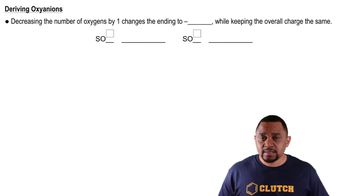Textbook Question
Using the periodic table to guide you, predict the chemical formula and name of the compound formed by the following elements: (d) K and S.
 Verified step by step guidance
Verified step by step guidance



Using the periodic table to guide you, predict the chemical formula and name of the compound formed by the following elements: (d) K and S.
The most common charge associated with scandium in its compounds is . Indicate the chemical formulas you would expect for compounds formed between scandium and b. sulfur
Predict the chemical formula for the ionic compound formed by (a) Ca2+ and Br-
Predict the chemical formula for the ionic compound formed by (c) Al3+ and CH3COO-
Predict the chemical formula for the ionic compound formed by (d) NH4+ and SO42-
Predict the chemical formula for the ionic compound formed by (e) Mg2+ and PO43-.